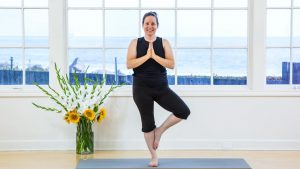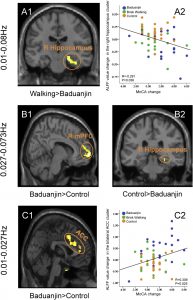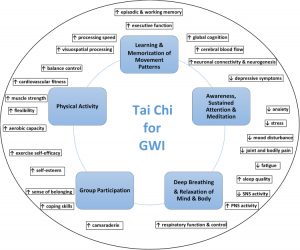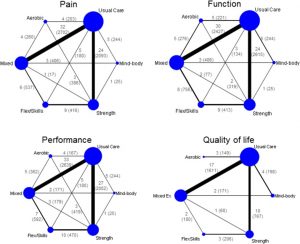Reduce Incontinence in Women with Yoga
By John M. de Castro, Ph.D.
“The pelvic floor is an instrumental player in the health and function of your bladder. Specifically, the perineum and the dynamic layers of muscle that compromise the inner pelvis, which are active in the passage of urine and control of the bladder. If you do experience leaks . . . strengthening your perineum with yoga will isolate the muscle, only furthering your ability to reduce leaks caused by incontinence.” – TENA
Urinary incontinence is common, particularly in women, and involves an involuntary loss of urine. This can range from slightly bothersome to debilitating. Possible public humiliation results in many women refraining from otherwise enjoyable public activities. This occurs due to problems with nerves and weakening of muscles that normally hold or discharge urine. Urinary incontinence occurs in about 10% of women and 2% of men under age 65 and 35% of women and 22% of men over age 65. Treatment can involve exercise, drugs, electrical stimulation, or even surgery.
Effective exercises for urinary incontinence strengthen the muscles of the pelvic floor and sphincter muscles. Yoga is a gentle exercise with a number of poses that strengthen the pelvic floor. In addition, yoga practice increases body awareness helping the individual to better sense and control the muscles involved. Also, yoga can reduce anxiety and stress which can contribute to urinary incontinence. So, it would seem reasonable to examine the application of yoga exercises for the treatment of urinary incontinence.
In today’s Research News article “A group-based yoga program for urinary incontinence in ambulatory women: feasibility, tolerability, and change in incontinence frequency over 3 months in a single-center randomized trial.” (See summary below or view the full text of the study at: https://www.ncbi.nlm.nih.gov/pmc/articles/PMC6314206/?report=classic), Huang and colleagues recruited older women (> 50 years of age) who had urinary incontinence and provided them with a “written pamphlet providing basic patient-directed information about behavioral self-management of incontinence (such as pelvic floor exercises and timed urination) consistent with usual first-line care.” They were randomly assigned them to either receive additional 3 months, twice a week for 90 minutes, of yoga training or non-specific muscle stretching and strengthening. They were also asked to practice at home for an hour at least once a week. The yoga poses taught were selected to improve bladder control. They were measured before and after training for safety, feasibility, frequency of incontinence, and incontinence quality of life.
They found that over the 3-month program incontinence decreased by 76% in the yoga group and 56% in the exercise group, stress induced incontinence decreased by 61% in the yoga group and 35% in the exercise group. Group differences were not statistically significant. Participation rates were high and no serious adverse events were reported.
Yoga training produced on average superior results to the exercise program the lack of a statistically significant difference does not allow definitive conclusions. Yoga practice has been shown to reduce the effects of stress on the individual. So, the reduction in stress induced incontinence would be expected. Hence, the results make it clear that yoga training is a feasible, safe, and effective treatment for urinary incontinence in older women.
So, reduce incontinence in women with yoga.
“yoga can help women who suffer from urinary incontinence by improving pelvic health and help gain more control over their bladders.“ – Attends
CMCS – Center for Mindfulness and Contemplative Studies
This and other Contemplative Studies posts are also available on Google+ https://plus.google.com/106784388191201299496/posts and on Twitter @MindfulResearch
Study Summary
Huang, A. J., Chesney, M., Lisha, N., Vittinghoff, E., Schembri, M., Pawlowsky, S., … Subak, L. (2019). A group-based yoga program for urinary incontinence in ambulatory women: feasibility, tolerability, and change in incontinence frequency over 3 months in a single-center randomized trial. American journal of obstetrics and gynecology, 220(1), 87.e1–87.e13. doi:10.1016/j.ajog.2018.10.031
Structured Abstract
Background:
Due to the limitations of existing clinical treatments for urinary incontinence, many women with incontinence are interested in complementary strategies for managing their symptoms. Yoga has been recommended as a behavioral self-management strategy for incontinence, but evidence of its feasibility, tolerability, and efficacy is lacking.
Objectives:
To evaluate the feasibility and tolerability of a group-based therapeutic yoga program for ambulatory middle-aged and older women with incontinence and examine preliminary changes in incontinence frequency as the primary efficacy outcome after 3 months.
Study Design:
Ambulatory women aged 50 years or older who reported at least daily stress-, urgency-, or mixed-type incontinence, were not already engaged in yoga, and were temporarily willing to forgo clinical incontinence treatments were recruited into a randomized trial in the San Francisco Bay area. Women were randomly assigned to take part in a program of twice weekly group classes and once weekly home practice focused on Iyengar-based yoga techniques selected by an expert yoga panel (yoga group) or a non-specific muscle stretching and strengthening program designed to provide a rigorous time-and-attention control (control group) for 3 months. All participants also received written, evidence-based information about behavioral incontinence self-management techniques (pelvic floor exercises, bladder training) consistent with usual first-line care. Incontinence frequency and type were assessed by validated voiding diaries. Analysis of covariance models examined within- and between-group changes in incontinence frequency as the primary efficacy outcome over 3 months.
Results:
Of the 56 women randomized (28 to yoga, 28 to control), mean age was 65.4 (±8.1) years (range 55–83 years), mean baseline incontinence frequency was 3.5 (±2.0) episodes/day, and 37 (66%) had urgency-predominant incontinence. Fifty women completed their assigned 3-month intervention program (89%), including 27 in the yoga and 23 in the control group (P=0.19). Of those, 24 (89%) in the yoga and 20 (87%) in the control group attended at least 80% of group classes. Over 3 months, total incontinence frequency decreased by an average of 76% from baseline in the yoga and 56% in the control group (P=0.07 for between-group difference). Stress incontinence frequency also decreased by an average of 61% in the yoga group and 35% in controls (P=0.045 for between-group difference), but changes in urgency incontinence frequency did not differ significantly between groups. Forty-eight non-serious adverse events were reported, including 23 in the yoga and 25 in the control group, but none were directly attributable to yoga or control program practice.
Conclusions:
Findings demonstrate the feasibility of recruiting and retaining incontinent women across the aging spectrum into a therapeutic yoga program and provide preliminary evidence of reduction in total and stress-type incontinence frequency after 3 months of yoga practice. When taught with attention to women’s clinical needs, yoga may offer a potential community-based behavioral self-management strategy for incontinence to enhance clinical treatment, although future research should assess whether yoga offers unique benefits for incontinence above and beyond other physical activity-based interventions.
https://www.ncbi.nlm.nih.gov/pmc/articles/PMC6314206/?report=classic









